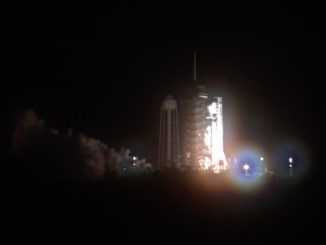
Update 5:46 p.m. EDT: SpaceX confirms successful deployment of all payloads.
SpaceX launched its Falcon 9 rocket from Vandenberg Space Force Base, sending dozens of spacecraft into orbit with its latest rideshare mission launching from California. The rocket’s first stage booster touched down back near the launch site following stage separation, creating a sonic boom for those nearby.
Liftoff from Space Launch Complex 4 East (SLC-4E) happened 11:56 a.m. PDT (2:56 p.m. EDT, 1856 UTC). The satellites will be deployed over a more than two-hour-long period.
The Falcon 9 first stage booster supporting the mission, tail number B1075 in the SpaceX fleet, launched for a 12th time. It previously supported the launches of SDA-0A, SARah-2 and nine Starlink missions.
About seven-and-a-half minutes after liftoff, B1075 touched down at Landing Zone 4. It marked the 20th landing at LZ-4 and the 340th booster landing for a Falcon rocket.
Earth-imaging, methane-tracking, water-managing and more
The mission marks the latest opportunity for several dozens of payloads to head to orbit without finding individual launch vehicles. Transporter-11 includes spacecraft from countries around the world, including Japan, Chile, the United Kingdom and Australia.
The Australian Space Agency noted that it has three spacecraft onboard: Kanyini, Waratah Seed-1 and Cuava-2. The Waratah Seed-1 is itself a rideshare mission, which will host the Perovskites in Orbit Readiness Test (PORT-2), Submillimeter Particle Detection System (SPaDeS) and Spiral Blue Space Edge-1 (SE-1) payloads onboard a 6U CubeSat.
Chile-based company, Lemu, is launching its Lemu Nge satellite, which it called “the first one exclusively designed to observe Earth’s biodiversity.”
“Lemu Nge will characterize the wetlands in Chile under the Ramsar Convention, an international treaty for the conservation and sustainable use of these ecosystems,” the company wrote on social media. “There are 16 Ramsar sites in the country (363,925 ha) and observations will be made from the highlands to Tierra de Fuego.”
🛰️ Our satellite Lemu Nge launches TODAY, Friday, August 16th, 2024! 🛰️
SpaceX has publicly announced that the Transporter-11 mission is ready to go 🚀
Join us today at 12:30 p.m. (Chilean time) on Lemu’s YouTube channel for our launch event. 🗓️
See you there! 3️⃣ 2️⃣ 1️⃣ 🚀 💫 pic.twitter.com/NaILrwe1iv
— Lemu 🌍 (@LemuEarth) August 16, 2024
The California-based company, Planet Labs PBC, will be launching 36 more of its Earth-imaging SuperDove satellites along with hyperspectral satellite, Tanager-1. This methane-sensing satellite is a collaboration between Planet, the Carbon Mapper Coalition and NASA’s Jet Propulsion Laboratory.
“Tanager-1 is optimized for point source mapping, meaning it has the ability to identify methane and CO2 emissions down to the scale of individual facilities and pieces of equipment, like leaking gas pipelines, venting coal mines or a leak in a landfill gas capture system,” wrote the Carbon Mapper Coalition.
“Carbon Mapper will use observations from Tanager-1 to provide transparent emissions data on its data portal, vastly scaling up the tens of thousands of plumes already available on this public platform.”

Additionally, NASA is flying two CubeSats from its Pathfinder Technology Demonstrator (PTD) series. The PTD-4 mission will “demonstrate a very high-power, low-volume deployable solar array with an integrated antenna called the Lightweight Integrated Solar Array and anTenna, or LISA-T, developed by NASA’s Marshall Spaceflight Center in Huntsville, Alabama.”
The PTD-R satellite, named “Deep Purple,” meanwhile will “demonstrate simultaneous ultraviolet (UV) and short-wave infrared optical sensing from space for the first time via two 85-mm aperture monolithic telescopes mounted side-by-side, using a new compact custom electronics module and a novel, lightweight, carbon-composite optical housing and radiator.”
The mission also marks a milestone for satellite deployment company, Exolaunch. The Transporter-11 mission marks its 30th launch/integration to date. It’s responsible or the integration of 42 out of the 116 satellites on this mission, representing more than two dozen companies.
“We are immensely grateful to our customers for their unwavering trust and confidence in Exolaunch. Their support is the cornerstone of our success and innovation,” said Robert Sproles, CEO of Exolaunch in a statement. ““We also extend our deepest appreciation to SpaceX for their thorough launch preparations. Falcon 9’s quick return to the launch pad demonstrates their resilience and steadfast commitment to excellence.”



